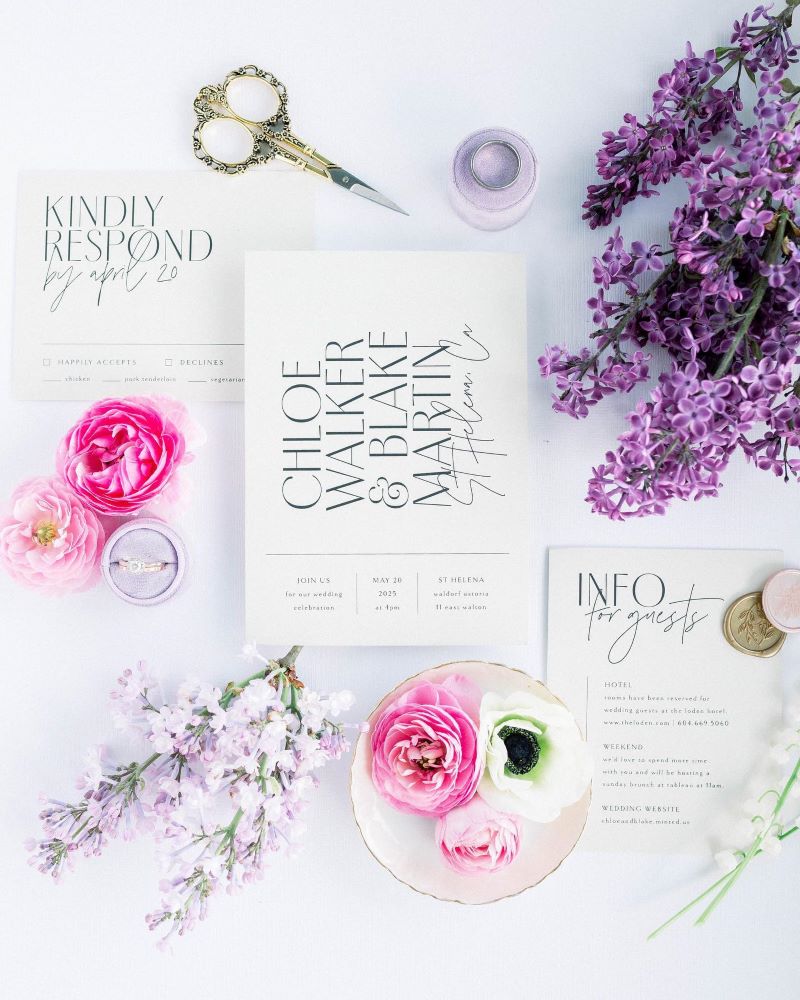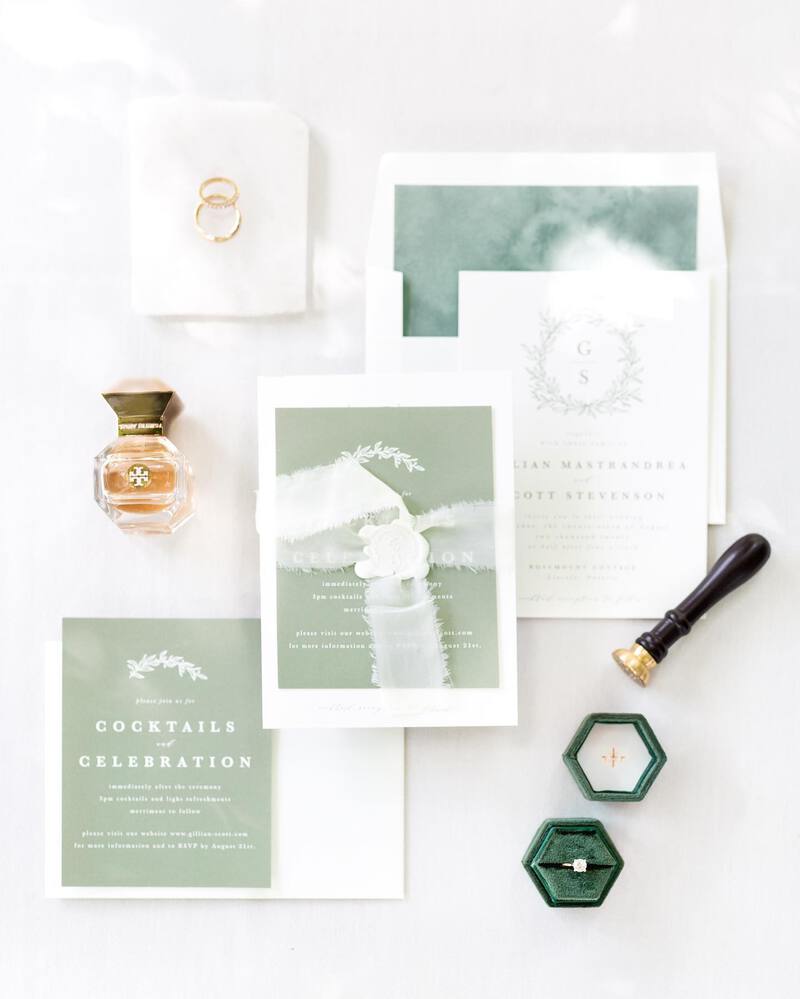You already know that planning a wedding comes with dozens (sometimes hundreds!) of little details to keep track of. And while not every single one of those details needs to be communicated to your guests — there will definitely be information outside of the basics of your ceremony time and place that you’re going to need to share with them.
Enter wedding details cards. These are the additional pieces of stationery that make up your wedding invitation suite — because sometimes you have too much fun information to share than can fit on a single invitation card.
In this article, we’ll dive into everything you need to know about detail cards, so you can decide exactly what you need for your big day. Happy planning!

Minted Invitation Suite: Etchings of Roses by Chris Griffith
Photo by Charla Storey
Pro Tip: Minted’s wedding stationery suites offer coordinating designs between the main invitation cards, details cards, RSVP cards, envelopes, and wedding websites. In addition to that, you can carry the invitation themes to your day-of through the place cards, menu cards, signs, programs, and more.
What is a Wedding Details Card?
A wedding details card is a card (or series of cards) separate from your wedding invitation that contains additional information about your big day such as dress code, reception location and directions, accommodation, registry information, and more.
Also known as enclosure cards, these cards were crucial for communicating everything guests needed to know about a wedding weekend in the era before wedding websites. Today, including detail cards has become optional for couples, with some choosing to host all of that information solely on their wedding website. That said, many couples still choose to include at least one detail card in their suite to avoid cluttering the design of their carefully-selected invitation with too much text. (Not sure what’s the right move for you? Don’t worry, we’ll walk you through how to decide if you’ll need detail cards or can skip them in favor of your wedding website later in this article.)

Photo by Marya Juliann Photography
What to Include in a Wedding Details Card
The specific information that must be included on a wedding details card can vary based on the couple and the type of celebration they’re holding. That said, typically a wedding details card will include…
- Accommodation/travel information such as room blocks, recommended airports, etc.
- Reception information, if hosted in a location separate from the ceremony
- Dress code
- Transportation information, including shuttle bus timing and pick up/drop off locations
- Day-of itinerary, including start and end times for the ceremony, cocktail hour, and reception
- Information pertaining to any additional wedding weekend events, such as welcome parties, rehearsal dinners, and goodbye brunches
- Registry information
Depending on the size and scope of your wedding, you may decide that some of these details warrant stand-alone enclosure cards of their own, which we’ll dive deeper into in the next section of this article.
But, if you plan to include just one detail card alongside your formal invitation, focus on the details that are absolutely crucial for your guests to understand where they need to be at what time. Anything else can be left to your wedding website!
9 Types of Wedding Detail Cards & How to Word Each
Because there can be so much information to share with guests about your wedding, there is a huge range of detail cards that you can include in your wedding suite. Here we break down the nine most common types of detail cards, providing examples and wording tips for each.
Wedding Day Information Cards
While your main invitation card will include the time, date, and location of your wedding, there isn’t always enough space to include all of the details of your big day without compromising design. That’s where a wedding day information card comes in — this is where you can share information like dress code, if children are included, weather expectations (if hosting an outdoor wedding in a season where the weather can be unpredictable), and a general timeline of the day.
How to Word Wedding Day Information Cards
Be as clear and straightforward as possible, as you’ll likely be trying to communicate quite a bit of information onto this single card. Typically, you’ll want to put the most important information at the top — here’s an example of how you could word a details card.
CEREMONY
4:30 p.m. Join us on the lawn for a welcome drink and find your seat
5:00 p.m. Ceremony begins
RECEPTION
5:30 - 6:30 p.m. Enjoy cocktails in the Western Courtyard
6:30 - 10:00 p.m. Dinner & dancing
DRESS CODE
Cocktail attire
The ceremony will be outdoors, sunglasses are encouraged
Please RSVP on our wedding website.
Response Cards
These are the wedding enclosure cards that couples tend to be most familiar with. Response cards are where guests can mark their RSVP, and typically also include space for guests to identify a plus one, choose their preferred entre for the reception, and share any food allergies.
While many couples opt to keep track of RSVPs online, it may be a good idea to still include a response card that provides detailed instructions for how to access the website and where to go to RSVP — especially if you plan to invite many older guests who may not have navigated an online RSVP system before.
How to Word Response Cards
Response cards tend to be quite small, so it is best to keep things brief. Just be sure to include a deadline for a response (typically four weeks before your wedding date). If you need guests to RSVP for multiple events — such as a rehearsal dinner and goodbye brunch in addition to the wedding day — be sure to include line items for those as well.
Accommodation Cards
We highly recommend you include accommodation cards in your invitation suite if you’re hosting a destination wedding or if you will have a lot of guests coming in from out of town. If you’re hosting your wedding within the hotel where you have your room block booked, you could also use this card to provide direction information.
How to Word Accommodation Cards
This is the place where you can share details of your room blocks, such as the hotel name and instructions for how to book, including the hotel’s phone number and website. If there is a deadline for when guests need to book their accommodations, be sure to include that as well.
Reception Cards
Reception cards are most useful if your ceremony and reception will be held in two different locations, or if there is a long break between the two. If your reception will take place directly after your ceremony and at the same venue, you can likely skip including reception cards in your invitation suite.
How to Word Reception Cards
Include the name and address of your reception venue along with the start time of the festivities — and be sure to note if there will be a cocktail hour taking place. If you have space, you may want to include directions for how to get from your ceremony location to the reception location (though you can also include those in a separate direction card, which we’ll get into in a moment).
Lastly, if there is a long break between your ceremony and reception in which you’d like to encourage guests to change (a common practice for Indian-American weddings, for example), be sure to include dress code information on your reception card.
Direction Cards
There are a few routes to take when it comes to direction cards (pun intended). If your ceremony and reception are in the same place, include directions from the hotel where the majority of your guests will be staying to your venue. If your ceremony and reception are in separate locations, it may be best to use your direction card to instruct guests on how to get from one venue to the other.
If your venue is difficult to find or is in an area that you know gets spotty cell service, including a custom map alongside written directions is something your guests are sure to appreciate.
How to Word Direction Cards
The key here is to keep it simple! Don’t worry about providing turn-by-turn instructions, as most guests will rely on GPS, Google, or Apple Maps.
Itinerary Cards
Wedding Weekend Itinerary Cards
If you have a full lineup of events surrounding your wedding including a detail card with an itinerary of everything going on is a great idea. This is also a nice way to encourage guests to mix and mingle with each other (and you!) if you’re hosting a destination wedding and know guests will be looking for ways to fill their days around the wedding.

Invitation Suite by Minted Custom Design Service
Photo by Ashley Teresa
How to Word Wedding Weekend Itinerary Cards
For each event that you’d like to invite guests to, be sure to include the following information:
- What the event is (Welcome Party, Beach Day, After Party, etc.)
- Venue Name and Address
- Start Time
- Dress Code
- If an RSVP is required
A general piece of etiquette: only include events that all of your wedding guests are invited to on this card. It is best to include a separate detail card for events with a more intimate guest count, such as a rehearsal dinner, instead of listing them on your general wedding weekend itinerary.
Rehearsal Dinner Cards
For guests that you’re inviting to your rehearsal dinner, you’ll want to include a separate rehearsal dinner card alongside the rest of your stationery suite. In recent years, separate rehearsal dinner invitations have become more popular with couples looking to set a separate tone for the rehearsal dinner and wedding day. (And because it is often easier to mail them out in separate envelopes than keep track of assembling different sets of invitations all at once.)
Rehearsal Dinner Card Wording
Whether you’re opting to include a rehearsal dinner card along with the rest of your invitation suite or are sending out a specific invitation, the details you’ll want to include are the same. Be sure to list the venue, start time, and dress code. You’ll also want to make it clear if you need guests to RSVP, or any other special instructions (such as no children or no plus ones allowed).
Other Event Cards
Welcome Party & Other Event Cards Cards
An alternate, more traditional, option to a wedding weekend itinerary card is to include separate cards with details for welcome parties, sangeets or mehndis, tea ceremonies, etc.. This is a good route to go if you only plan to invite a subset of your guest list to each event, or would like the chance to set a different aesthetic for each portion of your wedding weekend.
Welcome Party, After Party, and Goodbye Brunch Card Wording
In addition to making it clear what type of event you are inviting guests to attend, include the venue information, start time, and dress code. If you’re requiring RSVPs be sure to provide instructions for how to respond and a deadline for doing so. And, in the case that these events are being hosted by various family members, it can be a nice gesture to specify who the host or hostess will be.
Registry Cards
Lastly, it is traditional for couples to include wedding registry information in a separate detail card. While this practice has fallen off over the last few years as wedding websites have become more standard, you may still want to include a registry card directing your guests to your website if you know you’ll get lots of questions about it.
How to Word Registry Cards
List the stores where you are registered at (keep it at three stores max to avoid confusing your guests), as well as any pertinent instructions for how guests can purchase an item from your registry.
If you are not accepting gifts and encouraging your guests to make a donation on your behalf, it could also be nice to use a registry card to make that clear with wording like “We have everything we need. In lieu of a gift, we ask you to donate to [charity], a cause near and dear to our hearts.”
Wedding Details Cards vs Wedding Websites - Do You Need Both?
Today, most couples choose to host the vast majority of the information pertinent to their wedding on their wedding website — so do you still need to include detail cards along with your invitation? The answer, like so much of wedding planning, is very much up to your own personal preference and circumstances.
When it comes to deciding which — if any — detail cards you’d like to include, it can be useful to consider the following factors…
- Budget. If you’re sticking to a tight budget, or aren’t prioritizing your invitation suite as a top-line budget item, you may want to consider skipping detail cards (or including just one detail card).
- Tradition. Most of the detail cards we’ve discussed here are rooted in pre-internet wedding traditions. If maintaining that connection to history and tradition is important to you, you may want to include wedding detail cards alongside your wedding website.
- Formality. While the invitation suite design you choose will go a long way towards communicating the formality and scale of your big day, including a thick stack of detail cards wrapped in a belly band is a very clear way to let guests know that they should expect to be dazzled at your wedding.
- Guest Comfort. If you know a large portion of your guest list won’t be comfortable getting the information they need about your wedding online, you may want to include at least a few detail and enclosure cards to avoid being overwhelmed by individual questions.
We know that it is easy to get lost in the details of everything you need to communicate on your big day. We hope this deep dive into enclosure cards gave you a bit of clarity on what to include in your invitation suite. If you have questions, or could use a bit of design help, set up a time to chat with one of Minted’s stationery experts through our wedding concierge.














